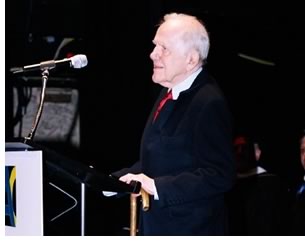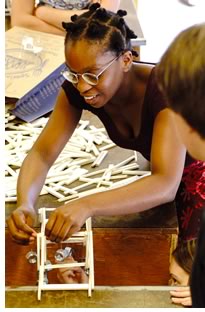

06/2005
Private gift to aid diverse high school students entering the design professions
 The Boston Architectural
Center teamed up with a private donor to award $1 million to diverse
high school students entering the school’s Center Summer Academy,
with continuing support through enrollment in the undergraduate program
and through entry into the profession. The grant—The Robert Houseman
and The Richard Kirkham Fund for Diverse High School Students Entering
the Design Professions—is one step toward addressing the deficiencies
and disparities of demographic diversity in the field.
The Boston Architectural
Center teamed up with a private donor to award $1 million to diverse
high school students entering the school’s Center Summer Academy,
with continuing support through enrollment in the undergraduate program
and through entry into the profession. The grant—The Robert Houseman
and The Richard Kirkham Fund for Diverse High School Students Entering
the Design Professions—is one step toward addressing the deficiencies
and disparities of demographic diversity in the field.
The funds will help “recruit, educate, mentor, and encourage young people who might not otherwise have considered careers in architecture or interior design,” says BAC President Ted Landsmark, Esq., PhD, Assoc. AIA. Landsmark, who also serves as chair of the AIA’s Diversity Committee and president-elect of the Association of Collegiate Schools of Architecture (ACSA), explains that students can spend two summers and then enroll in the school’s practice-based curriculum. A goal of the scholarship program is to provide a full range of support to underrepresented groups that has not existed in the past and to “support these young people until they become full-fledged members of the profession.” It had previously appeared that very few from underrepresented groups had gone on to become practicing professionals, Landsmark says. As a result, there will be increased attention to tracking the outcomes of the initial scholarship grantees.
 The donations came via Bill Houseman and the estate of his brother Robert
Houseman, an editor, residential designer-builder, and interior design
consultant who died in January 2004. The award is also in honor of Richard
Kirkham, a friend and business associate of Robert Houseman, who was
the co-founder of KirkBrummell, a fabric and wall-covering design company
in New York City. Aware of the efforts that had been made, particularly
at the entry point into the profession, Bill Houseman, himself a former
editor and a long-time writer for the National Council of Architectural
Registration Boards (NCARB), approached the BAC to see if they would
develop a program that would make it easier for underrepresented groups
to make a full transition to the architecture and design professions,
Landsmark says.
The donations came via Bill Houseman and the estate of his brother Robert
Houseman, an editor, residential designer-builder, and interior design
consultant who died in January 2004. The award is also in honor of Richard
Kirkham, a friend and business associate of Robert Houseman, who was
the co-founder of KirkBrummell, a fabric and wall-covering design company
in New York City. Aware of the efforts that had been made, particularly
at the entry point into the profession, Bill Houseman, himself a former
editor and a long-time writer for the National Council of Architectural
Registration Boards (NCARB), approached the BAC to see if they would
develop a program that would make it easier for underrepresented groups
to make a full transition to the architecture and design professions,
Landsmark says.
Ultimately, he concluded the two would be a good match. “The Boston Architectural Center recognizes the concept of a scholarship program for high schools student as an opportunity for introducing the design world to teenagers to seek out deserving, often under-represented young people. This is a unique opportunity for the BAC to fill a largely vacant role in academia and serve as a model for the design profession,” Houseman says.
 The BAC is using the Houseman and Kirkham funds, some of which arrived
the last week in May 2005, to begin to recruit students and enlist local
firms, educators, and AIA components in their efforts. The announcement
has generated more interest in the summer program. Each candidate is
evaluated for evidence of their interest in, commitment to, and passion
for the design profession.
The BAC is using the Houseman and Kirkham funds, some of which arrived
the last week in May 2005, to begin to recruit students and enlist local
firms, educators, and AIA components in their efforts. The announcement
has generated more interest in the summer program. Each candidate is
evaluated for evidence of their interest in, commitment to, and passion
for the design profession.
Part of wider effort
In 1968, then Urban League President Whitney Young Jr. chastised the
architecture profession for failing to provide opportunities for aspiring
minority designers. Today, only 1.5 percent of the profession is African
American, and percentages of women, Latinos, and other groups constituting
a major part of American culture remain grossly under-represented in
architecture. At this year’s national convention, Stanford Britt,
FAIA, the 2005 Whitney M. Young Jr. Award recipient, called on his
fellow architects to “recommit ourselves to reaching back and
helping others by doubling our scholarship program in 2007, our sesquicentennial
year. Despite what many may say ... very few of us make it on our own.
Helping others should be the ultimate goal of the AIA.”
Landsmark says the BAC funding is part of a wider effort to engage private individuals, firms, and components in an effort to address demographic disparities in the profession. “All schools can do more to nurture demographic change,” Landsmark says. “Our hope is that this kind of gift will encourage similar programs across the country.” The efforts involve the AIA national component, state and local components, firms, architecture schools, and private individuals, Landsmark advises.
 The Diversity Committee has published a book of essays that address
the current state of the lack of diversity in the profession and has
held conferences on diversity in the field in conjunction with Build
Boston. The group is also involved in a major research initiative into
the diversity of architecture that is about two-thirds complete, Landsmark
reports.
The Diversity Committee has published a book of essays that address
the current state of the lack of diversity in the profession and has
held conferences on diversity in the field in conjunction with Build
Boston. The group is also involved in a major research initiative into
the diversity of architecture that is about two-thirds complete, Landsmark
reports.
The gift, Landsmark says, is a good fit for the BAC, which offers a practice-based curriculum. The Center Summer Academy, offered since 1973, allows students entering grades 10-12 to gain experience in the field of design through hands-on projects, interactive learning, and educational field trips. Students leave CSA with a design portfolio and a solid sense of whether to pursue an education and career in architecture or interior design.
Copyright 2005 The American Institute of Architects.
All rights reserved. Home Page ![]()
![]()
 |
||
BAC
is accepting applications for the Center Summer Academy through
June 23. The CSA runs from July 5–August 5, Monday–Friday,
9 a.m. to 1 p.m. For more information, contact the BAC Continuing
Education Department at 617-585-0101 or csa@the-bac.edu or
visit the BAC Web site. Read the essays: “20 on 20/20 Vision,” Perspectives
on Diversity and Design.
|
||